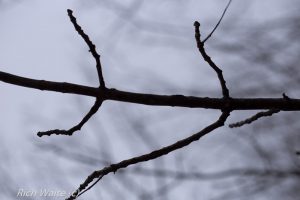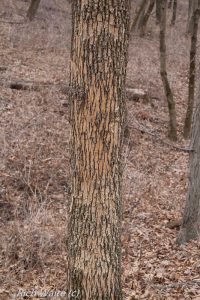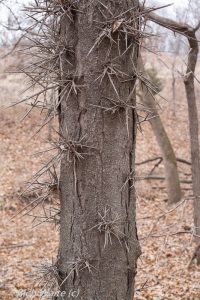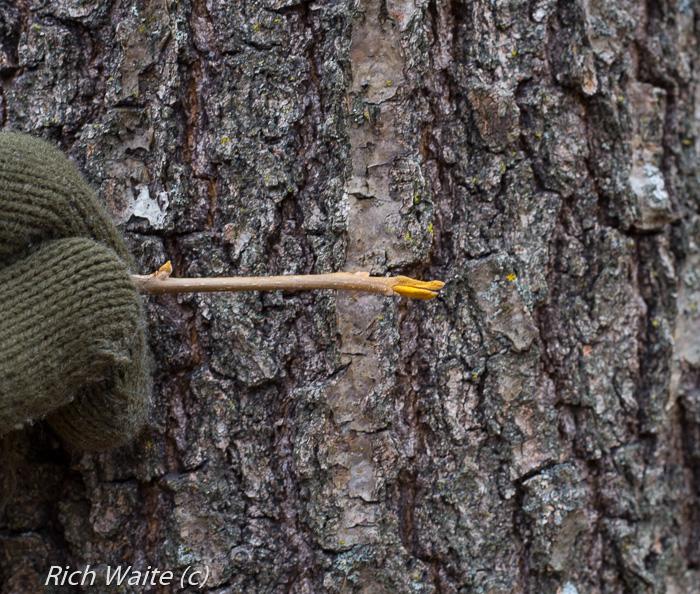Many Iowa landowners are really into managing wildlife and wildlife resources on their properties these days. That’s really good! And many landowners really understand the value of doing wise forest management. That’s fantastic too! But, while all intentions are good, many Iowa landowners could probably use a little help with tree identification. Let’s face it, identifying trees is no easy task, especially in the wintertime when most of the leaves are on the ground. Let’s take a look at a few quick pointers that should help you in your wintertime Iowa woods in regard to tree identification:
1). Walnut vs. Cottonwood
That’s right – these two species often get confused. Sometimes really confused! In fact, a forester friend of mine recently told me of a class he was teaching a while back on marking timber sales. The class members were let loose on a property and came back with over one-hundred thousand dollars worth of value on a bunch of big black walnut trees – some with veneer quality! They turned out to be all cottonwoods, with little to no value!
BIG mistake!
And these were forestry students with allot of education under their belts. This makes it pretty clear that you aren’t alone if you are getting the two species confused in your wintertime Iowa woodland. Check out the photo above for a quick way to tell the two apart with a little help of your pocket knife. Note, too, that ash can also be easily confused with black walnut. The same knife technique works on the bark — the ash has a light colored inner bark while that of the walnut is dark. The same knife technique works on the bark — the ash has a light colored inner bark while that of the walnut is dark.
2). Bitternut hickory:
This is a common understory tree in southern Iowa and if can get big, too. It doesn’t just stay in the understory like hophornbeam (ironwood). You’ll find bitternut hickory in the uplands mixed in with various oaks, You’ll find it in upland timber areas, commonly, mixed in with various oaks, hickory, and other species. It’s common on moist slopes and in bottomland areas too. You can recognize it in the understory by the mustard-colored buds (picture above).
3). American Elm

The twigs of the elm are much thinner than that of an oak — and the buds of the elm are much smaller too.
This tree, believe it or not, can be confused with white oak. And it’s best not to do that if you are doing timber stand improvement on your land! Elm has a thinner outer bark and smaller buds and twigs, than does white oak. American elm also, often, has somewhat of an exposed buttress root system. This can help separate it from white oak which too, which are less likely to have this trait.
4). White vs Red oak

This photo shows the distinctive color difference of the black oak and white oak (white oak in the foreground).
There are two oak groups in Iowa. The red oak group and the white oak group. The white oak group has five species and the red oak group has six species in Iowa. The white oak group has – which oak, chinkapin oak, bur oak, post oak and swamp white oak. The red oak group has red oak, black oak, pin oak, northern pin, blackjack oak, shingle oak A quick guide to separate the two groups is – and you probably saw this one coming – the color of the bark. The white oaks have whitish or lighter colored bark, as you may have also guessed. The red oak species have darker bark (usually). (See pictures above). Black oaks – a member of the red oak group, are a typical species in southern Iowa that mix in with the red oaks.
Unfortunately, Oak Wilt kills many really nice red and black oak trees in Iowa. It’s a disease that can be contained somewhat through good management practices but it still can reak havac on your forestland acres. Fortunately, the white oaks are pretty resistent to oak wilt and it doesn’t effect them very much normally. Oak Wilt PDF (ISU)

The smooth flat-topped ridge of a red oak helps to distinguish it from a black oak, which has rougher bark. Also, red oaks tend to have less lower branching than do black oaks. (But the two species do hybridize and that confuses the issue!)
The bark of black oak tends to be rougher than that of true red oaks and black oaks tend to have more lower branches – on average – than do the white oaks. True red oaks often have flat and fairly smooth ridges that are often lighter in color than the rest of the bark — ridges that may form sort of a loose diamond pattern on the tree trunk. Black oak and red oak can hybridize and take on characteristics of both. You tend to find more red oaks on north and east slopes and black oaks tend to occupy the dryer sites. White oak and black oaks often occur in roughly the same areas.
5). Shingle oak (red oak family)
Members of the red oak family tend to hold onto their leaves well into, and even throughout, winter until the buds start to swell in the spring. That’s something good to remember. And for sure, shingle oak, black oak, and pin oak can look allot alike! But, you can tell shingle oak easily by the leaf. Shingle oaks have a single, elliptical, oval, shaped leaf with no “lobes”. (picture above). No other Iowa oak has a leaf that looks anything like this.
6). Ironwood (Hophornbeam)

Hophornbeam — ironwood — gets this size and a bit bigger and often forms into dense stands in the understory. It can look like young white oak, but the leaves of the ironwood resemble those of an elm, not an oak, and the twigs and buds are slender and small on the ironwood.
Ironwood can fool you into thinking that you are looking at a young white oak. Ironwood is a common understory tree and often forms dense stands. It often carries leaves in the winter that resemble elm (not oak). Also, the bark is thinner than oak and so are the twigs and buds.
7). Ash

Cutting into the bark of an ash tree will tell you if it’s really a walnut — since the two are easily confused. The ash tree has light inner cambium and the walnut is dark.
I remember as a kid riding my motocross bike up and down our gravel driveway with my friends. We had a lot of fun racing them around that’s for sure. Though, I’m not quite sure how much the neighbors loved the noise! It’s a weird recollection to be sure, but every time I see the bark of a big old ash tree it reminds me of the tread I used to see on the back tire of my friends Suzuki RM 80 that always seemed to be in front of me! If you examine the bark of an ash, especially on a big older tree, you’ll also notice that it forms a diamond sort of arrangement across the surface, and the “peaks” sort of look like the tread of a dirt bike (sort of, you have to use your imagination a bit!) And as you can see from the picture above — the knife in your pocket will separate this tree from any possible confusion with this tree and the black walnut.
As for the twigs on ash trees, they have an opposite arrangement. This is a dead giveaway, in comparison to walnut and some others they may be confused with. (picture below) Also, the dreaded emerald ash borer is killing ash trees all over Iowa. The young ash tree pictured below — bottom right — is a recent victom and is showing signs of the disease. Unfortunately, there are several diseases and insects that kill trees of various species across the state. You can find out more about all sort of tree diseases/pests/problems.

Branches arranged in “opposite” formation from each other is a key characteristic of ash — this easily distinguishes it from any walnut confusion!

The emeral ash borer has moved into Iowa and is killing the ash trees! This young tree is showing serious symptoms of the disease.
8). Hackberry

The two hackberry trees — on the left — have deep rough ridges. (elm tree far right). The hackberry tree is pretty easy to identify once you’ve seen it a few times and it’s a good wildlife tree.
Hackberry tree often have deep cuts and ridges in the bark forming a very rough outer bark layer. A common tree with a good wildlife value – various animals eat the seeds. No other tree really looks that much like it, in Iowa, that I can think of. But you still need to know what it looks like to identify it!
9). The dreaded honey locust!
The thorns on the honey locust can run up to 8- inches or so and are very sharp. One interesting thing about these trees is that bout 10% of them, in Iowa, are thornless. The trees that do have thorns can easily go right through your boot or tractor tire, so watch out! But, honey locusts are great trees to leave for deer because whitetails love eating the seed pods in winter. Deer often seem to favor pods off certain trees vs. other for some reason. This one is easy to I.D! (Black locust trees may seem similar but tend to form straighter trunks and have smaller spines, than that of honey locust trees. Black locusts were often planted in the “pioneer” days for fence posts and firewood, and you can see groups of black locust tree, often, around homesteadsteds.

Most people can’t mistake this tree for anything else — the honey locust. It has scary sharp spines that’ll go right through a tractor tire or boot. But, it does produce seed pods that deer love to eat in the wintertime!
10). Shagbark Hickory
This one is pretty easy for most folks to I.D., because of the long scaly bark. A common upland tree in Iowa, occurs in groups of mixed with oaks. Can dominate dryer sites.

The scally bark of this shagbark hickory is hard to confuse with anything really. These trees are common in the upland woods and can dominant dry sites.
For more help identifying tree in Iowa be sure to check out ISU’s interactive tree guide!
We also have lots of useful resources on our resources page (makes sense, right?)
You might want to get Iowa Trees and Plants Iowa Trees and Plants (PDF)






